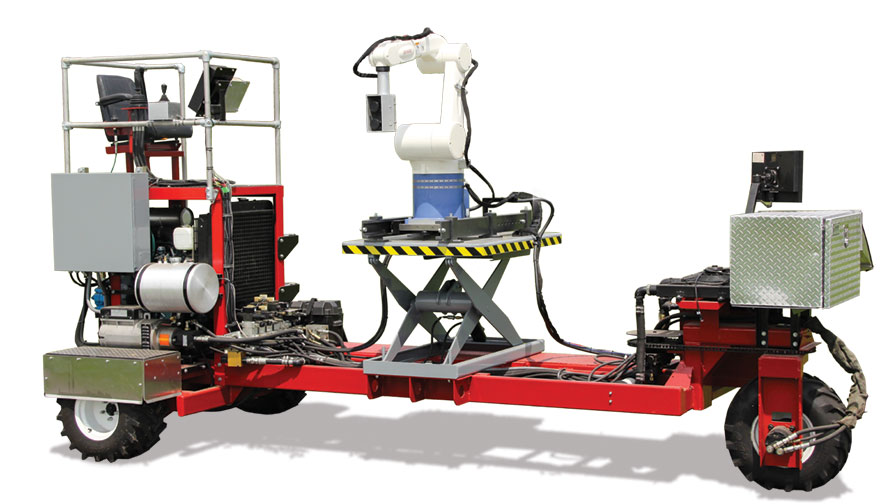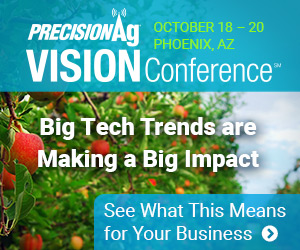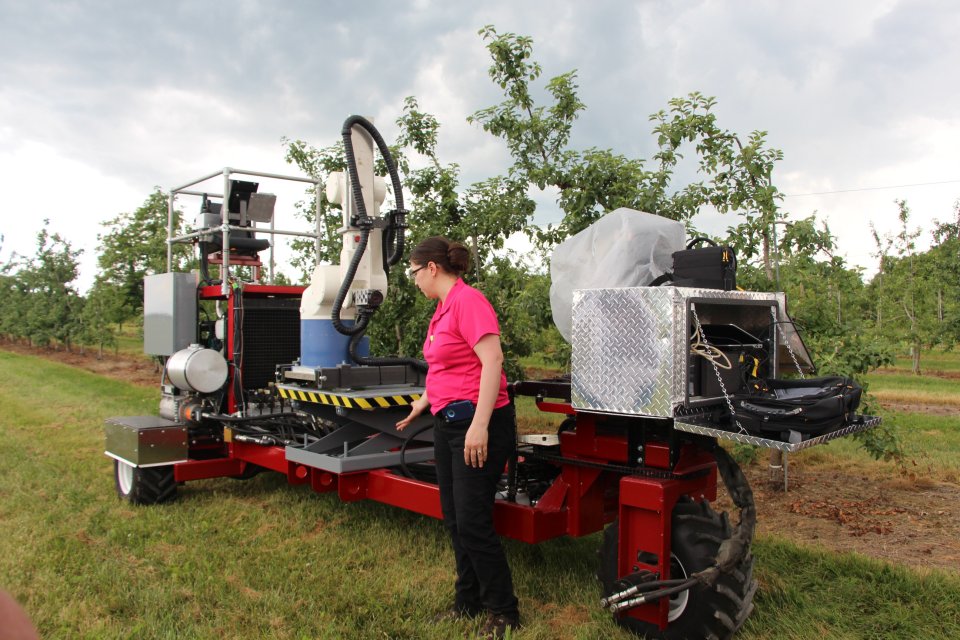Pruning Goes High-Tech

The prototype used in Amy Tabb’s robotic pruner project. (Photo: Amy Tabb)
Developments in robotic apple harvesters are gaining much attention within the apple industry. However, researchers from USDA, Purdue University, Penn State University, and commercial partner Vision Robotics of San Diego, CA, are focusing their efforts on the early part of the season — robotic dormant pruning. The researchers, who are working on two separate but similar projects, believe sensors in these autonomous devices will more easily assess a tree’s structure for dormant pruning, which will save on labor costs.
According to Peter Hirst, Professor of Horticulture at Purdue University, pruning accounts for about 20% to 25% of growers’ labor costs, and most rely on migrant labor to perform the tasks. However, growers this year are already experiencing difficulty in securing migrant labor.
So, what does an already-stressed labor supply mean for the future of orchard tasks? This is where the research team steps in, thanks to a $6 million USDA-Specialty Crop Research Initiative (SCRI) grant.
 QUANTIFYING ‘IT LOOKS RIGHT’
QUANTIFYING ‘IT LOOKS RIGHT’
Many growers will tell you pruning tall spindle apple trees is a science. Others will say it is an art form. Hirst, who has spoken about the robotic pruning project at many winter meetings, says most growers prune until “it looks right.”
However, robots aren’t able to quantify what looks right — computing systems need to know exactly what to cut and where. It’s this need for measurement which helped fuel the relationship between Penn State
Professor of Pomology Jim Schupp’s original seven — now four — simple pruning rules and the robotic pruning project.
There is a hierarchy to the rules, and pruners must complete Rule No. 1 before moving on to Rule No. 2, and so forth. This turns the process from art to science. Schupp estimates the first rule is responsible for about 70% of the cuts made to the tree.
“Primary and most important is removing limbs from the spindle that are too big,” he says. “The renewal cut is made to encourage a new, smaller branch to regenerate.”
Beginning in 2013, Schupp, along with research assistants Edwin Winzeler and Melanie Schupp, evaluated six levels of pruning severity, setting severity by calculating the ratio of limb diameter to trunk diameter, and always removing the next largest limb. By applying one rule and doing it consistently, they were able to develop a strong degree of predictability for the outcomes of pruning: light distribution, yield, and fruit size.
“We can now prune with a goal in mind,” he says.
A DEEPER DIVE
The team also studied whether the type of cut influenced the effect of the shoot that is regenerated, something Schupp says he’s preached for many years. Interestingly enough, there was no influence found from the type of cut.
“The stub shape had no effect on what came out,” he says. “None of the cuts had an effect on shoots, and where the branch came out or branch angle.”
This is a promising discovery, as rules could be programmed into an automated pruning device and the type of cut made would not impact the new growth. As of now, Schupp would like to see Rule 1 — which accounts for 70% of the cuts and “90% of the benefit” be the first step in the automated pruner.
“Do one thing and do it well,” he says. “Removing large limbs is a monotonous, time-consuming, and strenuous job for humans.”
This leaves the other 30% of pruning tasks in Rules 2 through 4 to an experienced pruning crew. Schupp says these rules are designed to take the guesswork out of pruning. But, also to help boost efficiency through clear, direct pruning directions.
Hirst and graduate student Jacob Franzen evaluated the effectiveness of Schupp’s rules-based pruning with an inexperienced crew using his rules vs. traditional pruning with a commercial pruning crew, who did not use his rules. Hirst says result with the inexperienced crew was same as what an experienced crew could do, which allows the research team to boil down pruning and apply it automation.

Amy Tabb, Agricultural Engineer at USDA’s Appalachian Fruit Research Laboratory in Kearneysville, WV, explains how the robotic imaging system for orchard automation develops a 3-D image of each tree’s structure. (Photo credit: Christina Herrick)
USDA’S PROTOTYPE
Amy Tabb, Research Agricultural Engineer at the USDA-Agricultural Research Service Research Station in Kearneysville, WV, has been working on a similar project since the mid-2000s as a graduate student at Purdue University. In Tabb’s prototype, two cameras acting as sensors are mounted on a robotic arm that scan the tall spindle trees.
“The robotic arm moves around getting a lot of images from a lot of different positions, and some programs that I’ve written convert those images into an estimate of the tree shape. They also estimate where the branches are and what their diameters are,” she says.
Tabb says acquiring the images takes about a minute and a half, and then the system finds the tree shape, which takes about four to six minutes. What’s been the biggest challenge is to have the vision system sense and estimate the tree canopy, Tabb says.
“Trees don’t have much visual texture so you can’t tell one part of the tree from a different part of the tree,” she says.
ECONOMIC DRIVER
As Penn State began to develop its pruning strategies, growers were not only surveyed about the rules but also to assess where new technologies may fit into their orchards.
Growers estimated they pay a pruning crew approximately $324 an hour total for pruning an acre of tall spindle trees. Growers said using the pruning rules would save the crews approximately 25% to 30% of time.
Tony Koselka, co-founder of Vision Robotics, says a big driver for automated pruning is the pruning season is longer than harvest, so it is possible to use the equipment for a longer period of time and to spread the cost out over months as opposed to the short harvest window. Not only is the harvest season shorter, it requires larger hand crews as it would for robots. Ideally for growers, it would be best to use the same equipment for several tasks during the growing season.
“It’s hard to amortize the cost of really expensive equipment over a month. Whereas if you have a task that occurs multiple times or can use the equipment for different tasks multiple times during the year, you can drive down the cost of ownership significantly.”
GETTING TO THE CUTS
Getting to the cutting phase, where Schupp’s rules will be applied, is the next focus. Tabb says she will be working on defoliated trees this summer, instead of just waiting for the leaves to drop and working on the project in the winter.
“You still have the things you can’t simulate inside and other things that aren’t the same as when you are working inside,” she says. “Once you have a good estimate of the tree shape, where the branches are and what the diameters are, then you would apply the pruning rules.”
Tabb also says deep learning, in which a system can learn and recognize patterns in images and data, could help to speed up the sensing and canopy capturing process, which will be a focus once she hits the cutting portion of the robotic pruning process.
LESSONS LEARNED
Tabb says the most important takeaway she’s learned so far is that the robotic vision system needs to be able to look at and “decode” everything in the canopy to decide if it’s a part of the tree or not — for example, flags, ties, or wires wrapped around trees.
“It’s almost like you are designing a set for the robot because it is a visual sensor — if you have things in your blocks that are visually confusing you may consider removing those or altering them for a visual system to work in your blocks,” she says.
One comment constantly heard is growing systems and production will have to change in order to successfully integrate robotics into the tree fruit industry.
Koselka says apple production is on the way, thanks to dwarfing trees and consistent canopies. But if growers of other tree fruits hope to introduce automation, trees will need to be scaled down to be viable.
“In some cases, they are going to have to change what their practices are, especially for things like harvest. They’re probably going to have to change their growing practices,” he says. “There are some trade-offs, on ease of use and how to make them work best vs. growing practices.”
But Hirst says what the team has learned with robotic pruning has helped re-examine what’s critically important in pruning.
“Results of the studies will automate pruning and improve human pruning,” he says.










